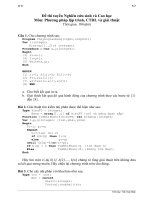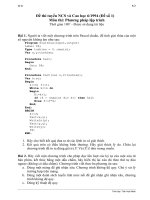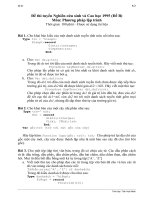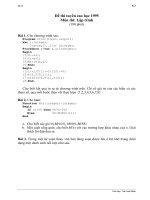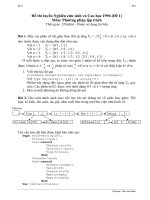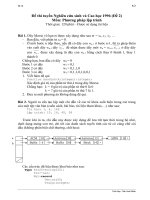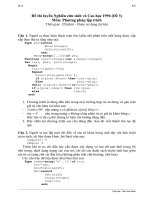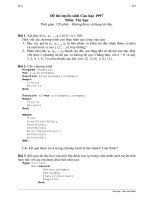lập trình ios ngôn ngữ lập trình objective c
Bạn đang xem bản rút gọn của tài liệu. Xem và tải ngay bản đầy đủ của tài liệu tại đây (8.24 MB, 289 trang )
ptg999
ptg999
Objective-C�Programming
THE�BIG�NERD�RANCH�GUIDE
AARON HILLEGASS
ptg999
Objective-C Programming
Objective-C Programming: The Big Nerd Ranch Guide
by Aaron Hillegass
Copyright © 2011 Big Nerd Ranch, Inc.
All rights reserved. Printed in the United States of America. This publication is protected by copyright, and
permission must be obtained from the publisher prior to any prohibited reproduction, storage in a retrieval system,
or transmission in any form or by any means, electronic, mechanical, photocopying, recording, or likewise. For
information regarding permissions, contact
Big Nerd Ranch, Inc.
154 Krog Street
Suite 100
Atlanta, GA 30307
(404) 478-9005
/>
The 10-gallon hat with propeller logo is a trademark of Big Nerd Ranch, Inc.
Exclusive worldwide distribution of the English edition of this book by
Pearson Technology Group
800 East 96th Street
Indianapolis, IN 46240 USA
The authors and publisher have taken care in writing and printing this book but make no expressed or implied
warranty of any kind and assume no responsibility for errors or omissions. No liability is assumed for incidental
or consequential damages in connection with or arising out of the use of the information or programs contained
herein.
App Store, Apple, Cocoa, Cocoa Touch, Instruments, Interface Builder, iOS, iPad, iPhone, iTunes, iTunes Store,
Mac, Mac OS, Objective-C, and Xcode are trademarks of Apple, Inc., registered in the U.S. and other countries.
Many of the designations used by manufacturers and sellers to distinguish their products are claimed as
trademarks. Where those designations appear in this book, and the publisher was aware of a trademark claim, the
designations have been printed with initial capital letters or in all capitals.
ISBN-100321706285
ISBN-13978-0321706287
Library of Congress Control Number:2011931707
Second printing, January 2012
ptg999
iii
Acknowledgments
It is a great honor that I get to work with such amazing people. Several of them put a lot of time and
energy into making this book great. I’d like to take this moment to thank them.
• Mikey Ward wrote several chapters of this book including Y o u r F i r s t i O S A p p l i c a t i o n , Y o u r F i r s t
Cocoa Program, and Blocks. If I were a nicer boss, I would have put his name on the cover.
• The other instructors who teach the Objective-C materials fed us with a never-ending stream of
suggestions and corrections. They are Scott Ritchie, Mark Fenoglio, Brian Hardy, Christian Keur,
and Alex Silverman.
• My tireless editor, Susan Loper, took my stream-of-consciousness monologue that stumbled across
e v e r y t h i n g a p r o g r a m m e r n e e d s t o k n o w a n d h o n e d i t i n t o a n a p p r o a c h a b l e p r i m e r .
• Several technical reviewers helped me find and fix flaws. They are James Majors, Mark Dalrymple,
Scott Steinman, Bart Hoffman, Bolot Kerimbaev, and Nate Chandler.
• Ellie Volckhausen designed the cover.
• Chris Loper at IntelligentEnglish.com designed and produced the EPUB and Kindle versions.
• The amazing team at Pearson Technology Group patiently guided us through the business end of
book publishing.
ptg999
This page intentionally left blank
ptg999
& ( '
!0 %!!!!!!!!!!!!!!!!!!!!!!!!!!!!!!!!!!!!!!!!!!!!!!!!!!!!!!!!!!!!!!!!!!!!!!!!!!!!!!!!!!!!!!!!!!!!!!!!!!!!!!!!!!!!!!
!K)(*!!!!!!!!!!!!!!!!!!!!!!!!!!!!!!!!!!!!!!!!!!!!!!!!!!!!!!!!!!!!!!!!!!!!!!!!!!!!!!!!!!!!!!!!!!!!!!! 1
>@"!!!!!!!!!!!!!!!!!!!!!!!!!!!!!!!!!!!!!!!!!!!!!!!!!!!!!!!!!!!!!!!!!!!!!!!!!!!!!!!!!!!!!!!!!!!! 1
+*+*!!!!!!!!!!!!!!!!!!!!!!!!!!!!!!!!!!!!!!!!!!!!!!!!!!!!!!!!!!!!!!!!!!!!!!!!!!!!!!!!!!!!!!!! .
+&&''+*!!!!!!!!!!!!!!!!!!!!!!!!!!!!!!!!!!!!!!!!!!!!!!!!!!!!!!!!!!!!!!!!!!!!.
!K),#'!!!!!!!!!!!!!!!!!!!!!!!!!!!!!!!!!!!!!!!!!!!!!!!!!!!!!!!!!!!!!!!!!!!!!!!!!!!!!!!!!!!!!!!!!!!!!!!!2
G"!!!!!!!!!!!!!!!!!!!!!!!!!!!!!!!!!!!!!!!!!!!!!!!!!!!!!!!!!!!!!!!!!!!!!!!! 2
0+A!!!!!!!!!!!!!!!!!!!!!!!!!!!!!!!!!!!!!!!!!!!!!!!!!!!!!!!!!!!!!!!!!!!!!!!!!!!!!!!!!2
B +L!!!!!!!!!!!!!!!!!!!!!!!!!!!!!!!!!!!!!!!!!!!!!!!!!!!!!!!!!!!!!!!!!!!!!!!!!!!! 6
+ )''L!!!!!!!!!!!!!!!!!!!!!!!!!!!!!!!!!!!!!!!!!!!!!!!!!!!!!!!!!!!!!!!!!!!!!!!!!!!!!! 1
%+'L!!!!!!!!!!!!!!!!!!!!!!!!!!!!!!!!!!!!!!!!!!!!!!!!!!!!!!!!!!!!!!!!!!!!!!!!!!!!!!!!!!!!! .
IG !!!!!!!!!!!!!!!!!!!!!!!!!!!!!!!!!!!!!!!!!!!!!!!!!!!!!!!!!!!!!!!!!!!!!!!!!!!!!!!!!!!!!!!!!!!!!!!!!!!!! -
!+#''B*!!!!!!!!!!!!!!!!!!!!!!!!!!!!!!!!!!!!!!!!!!!!!!!!!!!!!!!!!!!!!!!!!!!!!!!!!!!!!!!!!!!!!!!!!!!! 2
1!J (!!!!!!!!!!!!!!!!!!!!!!!!!!!!!!!!!!!!!!!!!!!!!!!!!!!!!!!!!!!!!!!!!!!!!!!!!!!!!!!!!!!!!!!!!!!!! 6
( ! ! ! ! ! ! ! ! ! ! ! ! ! ! ! ! ! ! ! ! ! ! ! ! ! ! ! ! ! ! ! ! ! ! ! ! ! ! ! ! ! ! ! ! ! ! ! ! ! ! ! ! ! ! ! ! ! ! ! ! ! ! ! ! ! ! ! ! ! ! ! ! ! ! ! ! ! ! ! ! ! ! ! ! ! ! ! ! ! ! ! ! ! ! ! ! ! ! ! ! ! ! ! ! ! ! ! ! 6
'+"!!!!!!!!!!!!!!!!!!!!!!!!!!!!!!!!!!!!!!!!!!!!!!!!!!!!!!!!!!!!!!!!!!!!!!!!!!!!!!!!!
!!!!!!!!!!!!!!!!!!!!!!!!!!!!!!!!!!!!!!!!!!!!!!!!!!!!!!!!!!!!!!!!!!!!!!!!!!!!!!!!!!!!!!!!!!!!!!!!!!!!!!
.! &8!!!!!!!!!!!!!!!!!!!!!!!!!!!!!!!!!!!!!!!!!!!!!!!!!!!!!!!!!!!!!!!!!!!!!!!!!!!!!!!!!!!!!!!!!!!!!!!!!!!!!!!!!!!!!!!! 1
"!!!!!!!!!!!!!!!!!!!!!!!!!!!!!!!!!!!!!!!!!!!!!!!!!!!!!!!!!!!!!!!!!!!!!!!!!!!!!!!!!!!!!!!!!!!! .
&!!!!!!!!!!!!!!!!!!!!!!!!!!!!!!!!!!!!!!!!!!!!!!!!!!!!!!!!!!!!!!!!!!!!!!!!!!!!!!!!!!!!!!!!!!!!!!!!!!!!!!!!!!! -
,?))734!!!!!!!!!!!!!!!!!!!!!!!!!!!!!!!!!!!!!!!!!!!! <
!!!!!!!!!!!!!!!!!!!!!!!!!!!!!!!!!!!!!!!!!!!!!!!!!!!!!!!!!!!!!!!!!!!!!!!!!!!!!!!!!!!!!!!!!!!!!!!!!!!!!! <
-!,) !!!!!!!!!!!!!!!!!!!!!!!!!!!!!!!!!!!!!!!!!!!!!!!!!!!!!!!!!!!!!!!!!!!!!!!!!!!!!!!!!!!!!!!!!!!!!!!!!!!!!!!!!!! 2
B) )&)L!!!!!!!!!!!!!!!!!!!!!!!!!!!!!!!!!!!!!!!!!!!!!!!!!!!!!!!!!!!!!!!!!!!!!!!!!! 2
+ +)&)L!!!!!!!!!!!!!!!!!!!!!!!!!!!!!!!!!!!!!!!!!!!!!!!!!!!!!!!!!!!!!!!!!!!!2
+&)+*!!!!!!!!!!!!!!!!!!!!!!!!!!!!!!!!!!!!!!!!!!!!!!!!!!!!!!!!!!!!!!!!!!!!!!!!!!!! 1
C"&'*!!!!!!!!!!!!!!!!!!!!!!!!!!!!!!!!!!!!!!!!!!!!!!!!!!!!!!!!!!!!!!!!!1
)!!!!!!!!!!!!!!!!!!!!!!!!!!!!!!!!!!!!!!!!!!!!!!!!!!!!!!!!!!!!!!!!!!!!!!!!!!!!!!!!!!!!!!!!!!!!!!!!!!!!!! 1.
C*&')!!!!!!!!!!!!!!!!!!!!!!!!!!!!!!!!!!!!!!!!!!!!!!!!!!!!!!!!!!!!!!!! 1-
) !!!!!!!!!!!!!!!!!!!!!!!!!!!!!!!!!!!!!!!!!!!!!!!!!!!!!!!!!!!!!!!!!!!!!!!!!!!!!!!!!!!!!!!!!!!!!!!!!!!!!!!!!!!! 12
0"!!!!!!!!!!!!!!!!!!!!!!!!!!!!!!!!!!!!!!!!!!!!!!!!!!!!!!!!!!!!!!!!!!!!!!!!!!!!!!!!16
!!!!!!!!!!!!!!!!!!!!!!!!!!!!!!!!!!!!!!!!!!!!!!!!!!!!!!!!!!!!!!!!!!!!!!!!!!!!!!!!!!!!!!!!!!!!!!!!!!!!!! .
<!)' !!!!!!!!!!!!!!!!!!!!!!!!!!!!!!!!!!!!!!!!!!!!!!!!!!!!!!!!!!!!!!!!!!!!!!!!!!!!!!!!!!!!!!!!!!!!!!!!!!!!!!!!!!!! .
&34 !!!!!!!!!!!!!!!!!!!!!!!!!!!!!!!!!!!!!!!!!!!!!!!!!!!!!!!!!!!!!!!!!!!!!!!!!!!!!!!!!!!!!!!!!!!!!!!!!!!!!!!!!! .
!!!!!!!!!!!!!!!!!!!!!!!!!!!!!!!!!!!!!!!!!!!!!!!!!!!!!!!!!!!!!!!!!!!!!!!!!!!!!!!!!!!!!!!!!!!!!!!!!!!!!!!!! .
(* & ! ! ! ! ! ! ! ! ! ! ! ! ! ! ! ! ! ! ! ! ! ! ! ! ! ! ! ! ! ! ! ! ! ! ! ! ! ! ! ! ! ! ! ! ! ! ! ! ! ! ! ! ! ! ! ! ! ! ! ! ! ! ! ! ! ! ! .
!!!!!!!!!!!!!!!!!!!!!!!!!!!!!!!!!!!!!!!!!!!!!!!!!!!!!!!!!!!!!!!!!!!!!!!!!!!!!!!!!!!
,)'!!!!!!!!!!!!!!!!!!!!!!!!!!!!!!!!!!!!!!!!!!!!!!!!!!!!!!!!!!!!!!!!!!!!!!!!!!!!!!!!!!!! .<
(* & & )' ! ! ! ! ! ! ! ! ! ! ! ! ! ! ! ! ! ! ! ! ! ! ! ! ! ! ! ! ! ! ! ! ! ! ! ! ! ! ! ! ! ! ! ! ! ! ! .<
,)&&)'!!!!!!!!!!!!!!!!!!!!!!!!!!!!!!!!!!!!!!!!!!!!!!!!!!!!!!!!!! .2
!!!!!!!!!!!!!!!!!!!!!!!!!!!!!!!!!!!!!!!!!!!!!!!!!!!!!!!!!!!!!!!!!!!!!!!!!!!!!!!!!!!!!!!!!!!!!!!!!!!!!! .2
2! C!!!!!!!!!!!!!!!!!!!!!!!!!!!!!!!!!!!!!!!!!!!!!!!!!!!!!!!!!!!!!!!!!!!!!!!!!!!!!!!!!!!!!!!!!!!!!!!!!!!!!!!!!!!!!!!! .6
(+ !!!!!!!!!!!!!!!!!!!!!!!!!!!!!!!!!!!!!!!!!!!!!!!!!!!!!!!!!!!!!!!!!!!!!!!!!!!!!!!!!!!!!!!!!!!!!!! .6
(& !!!!!!!!!!!!!!!!!!!!!!!!!!!!!!!!!!!!!!!!!!!!!!!!!!!!!!!!!!!!!!!!!!!!!!!!!!!!!!!!!!!!!!!!!!!!!!!!!! -
* !!!!!!!!!!!!!!!!!!!!!!!!!!!!!!!!!!!!!!!!!!!!!!!!!!!!!!!!!!!!!!!!!!!!!!!!!!!!!!!!!!!!!!!!!!!!!!!!!!!!!!!!!!!! -
ptg999
Objective-C Programming
vi
continue 52
The do-while loop 53
Challenge 54
8. Addresses and Pointers 55
Getting addresses 55
Storing addresses in pointers 56
Getting the data at an address 57
How many bytes? 57
NULL 58
Stylish pointer declarations 59
Challenges 59
9. Pass By Reference 61
Writing pass-by-reference functions 62
A v o i d d e r e f e r e n c i n g N U L L . . . . . . . . . . . . . . . . . . . . . . . . . . . . . . . . . . . . . . . . . . . . . . . . . . . . . . . . . . . . . . . . . . . . . . . . . . . . . . . 6 4
10. Structs 65
Challenge 66
11. The Heap 69
III. Objective-C and Foundation 73
12. Objects 75
Creating and using your first object 75
Message anatomy 77
Objects in memory 79
id 79
Challenge 80
13. More Messages 81
Nesting message sends 81
Multiple arguments 82
Sending messages to nil 82
Challenge 83
14. NSString 85
Challenge 86
15. NSArray 87
NSMutableArray 89
Challenges 90
16. Developer Documentation 93
Reference pages 94
Quick Help 96
Other options and resources 98
17. Your First Class 101
Accessor methods 103
Dot notation 104
Properties 105
self 106
Multiple files 106
Challenge 106
18. Inheritance 109
Overriding methods 112
super 113
ptg999
Objective-C Programming
vii
Challenge 113
19. Object Instance Variables 115
Object ownership and ARC 117
Creating the Asset class 118
Adding a to-many relationship to Employee 119
Challenge 123
20. Preventing Memory Leaks 125
Retain cycles 127
W e a k r e f e r e n c e s . . . . . . . . . . . . . . . . . . . . . . . . . . . . . . . . . . . . . . . . . . . . . . . . . . . . . . . . . . . . . . . . . . . . . . . . . . . . . . . . . . . . . . . . . . . . 1 2 9
Zeroing of weak references 130
F o r t h e M o r e C u r i o u s : M a n u a l r e f e r e n c e c o u n t i n g a n d A R C H i s t o r y . . . . . . . . . . . . . . . . . . . . . . . 1 3 1
Retain count rules 133
21. Collection Classes 135
NSArray/NSMutableArray 135
Immutable objects 135
Sorting 136
Filtering 137
NSSet/NSMutableSet 138
NSDictionary/NSMutableDictionary 140
C primitive types 142
Collections and nil 142
Challenge 143
22. Constants 145
Preprocessor directives 145
#include and #import 146
#define 146
Global variables 147
enum 148
#define vs global variables 149
23. Writing Files with NSString and NSData 151
Writing an NSString to a file 151
NSError 152
Reading files with NSString 153
Writing an NSData object to a file 154
Reading an NSData from a file 155
24. Callbacks 157
T a r g e t - a c t i o n . . . . . . . . . . . . . . . . . . . . . . . . . . . . . . . . . . . . . . . . . . . . . . . . . . . . . . . . . . . . . . . . . . . . . . . . . . . . . . . . . . . . . . . . . . . . . . . . . 1 5 7
Helper objects 160
Notifications 163
Which to use? 164
Callbacks and object ownership 164
25. Protocols 167
26. Property Lists 171
Challenge 173
IV. Event-Driven Applications 175
27. Your First iOS Application 177
Getting started with iTahDoodle 177
BNRAppDelegate 179
ptg999
Objective-C Programming
viii
Adding a C helper function 180
Objects in iTahDoodle 181
Model-View-Controller 182
The application delegate 183
Setting up views 184
Running on the iOS simulator 185
W i r i n g u p t h e t a b l e v i e w . . . . . . . . . . . . . . . . . . . . . . . . . . . . . . . . . . . . . . . . . . . . . . . . . . . . . . . . . . . . . . . . . . . . . . . . . . . . . . . . 1 8 6
Adding new tasks 189
Saving task data 189
F o r t h e M o r e C u r i o u s : W h a t a b o u t m a i n ( ) ? . . . . . . . . . . . . . . . . . . . . . . . . . . . . . . . . . . . . . . . . . . . . . . . . . . . . . . . . 1 9 0
28. Your First Cocoa Application 191
Edit BNRDocument.h 192
A look at Interface Builder 193
Edit BNRDocument.xib 194
Making connections 198
Revisiting MVC 202
Edit BNRDocument.m 202
Challenges 204
V . A d v a n c e d O b j e c t i v e - C . . . . . . . . . . . . . . . . . . . . . . . . . . . . . . . . . . . . . . . . . . . . . . . . . . . . . . . . . . . . . . . . . . . . . . . . . . . . . . . . . . . . . . . . . . . . . . . . 2 0 5
29. init 207
Writing init methods 207
A basic init method 208
Using accessors 209
init methods that take arguments 210
Deadly init methods 215
30. Properties 217
Property attributes 218
Mutability 218
Lifetime specifiers 218
Advice on atomic vs. nonatomic 220
K e y - v a l u e c o d i n g . . . . . . . . . . . . . . . . . . . . . . . . . . . . . . . . . . . . . . . . . . . . . . . . . . . . . . . . . . . . . . . . . . . . . . . . . . . . . . . . . . . . . . . . . . 2 2 1
Non-object types 222
31. Categories 225
32. Blocks 227
Defining blocks 227
Using blocks 228
Declaring a block variable 228
Assigning a block 229
P a s s i n g i n a b l o c k . . . . . . . . . . . . . . . . . . . . . . . . . . . . . . . . . . . . . . . . . . . . . . . . . . . . . . . . . . . . . . . . . . . . . . . . . . . . . . . . . 2 3 0
typedef 233
Return values 233
Memory management 234
The block-based future 235
Challenges 235
Anonymous block 235
NSNotificationCenter 236
VI. Advanced C 237
33. Bitwise Operations 239
ptg999
Objective-C Programming
ix
Bitwise-OR 240
Bitwise-AND 241
Other bitwise operators 242
Exclusive OR 242
Complement 243
Left-shift 243
Right-shift 244
Using enum to define bit masks 245
More bytes 245
Challenge 245
34. C Strings 247
char 247
char * 248
String literals 250
Converting to and from NSString 251
Challenge 252
35. C Arrays 253
36. Command-Line Arguments 257
37. Switch Statements 261
Next Steps 263
Index 265
ptg999
This page intentionally left blank
ptg999
P a r t I
Getting Started
ptg999
This page intentionally left blank
ptg999
3
1
Y o u a n d T h i s B o o k
Let’s talk about you for a minute. You want to write applications for iOS or MacOSX, but you haven’t
done much (or any) programming in the past. Your friends have raved about my other books (iOS
Programming: The Big Nerd Ranch Guide and Cocoa Programming for MacOSX), but they are
written for experienced programmers. What should you do? Read this book.
There are similar books, but this one is the one you should read. Why? I’ve been teaching people
how to write applications for iOS and the Mac for a long time now, and I’ve identified what you need
to know at this point in your journey. I’ve worked hard to capture that knowledge and dispose of
e v e r y t h i n g e l s e . T h e r e i s a l o t o f w i s d o m a n d v e r y l i t t l e f l u f f i n t h i s b o o k .
My approach is a little unusual. Instead of simply trying to get you to understand the syntax of
Objective-C, I’ll show you how programming works and how experienced programmers think about it.
Because of this approach, I’m going to cover some heavy ideas early in the book. You should not
e x p e c t t h i s t o b e a n e a s y r e a d . I n a d d i t i o n , n e a r l y e v e r y i d e a c o m e s w i t h a p r o g r a m m i n g e x p e r i m e n t .
This combination of learning concepts and immediately putting them into action is the best way to
learn programming.
C and Objective-C
When you run a program, a file is copied from the file system into memory (RAM), and the
instructions in that file are executed by your computer. Those instructions are inscrutable to humans.
So, humans write computer programs in a programming language. The very lowest-level programming
language is called assembly code. In assembly code, you describe every step that the CPU (the
computer’s brain) must take. This code is then transformed into machine code (the computer’s native
tongue) by an assembler.
Assembly language is tediously long-winded and CPU-dependent (because the brain of your latest
iMac can be quite different from the brain of your well-loved, well-worn PowerBook). In other words,
if you want to run the program on a different type of computer, you will need to rewrite the assembly
code.
T o m a k e c o d e t h a t c o u l d b e e a s i l y m o v e d f r o m o n e t y p e o f c o m p u t e r t o a n o t h e r , w e d e v e l o p e d “ h i g h -
level languages.” With high-level languages, instead of thinking about a particular CPU, you could
e x p r e s s t h e i n s t r u c t i o n s i n a g e n e r a l w a y , a n d a p r o g r a m ( c a l l e d a compiler) would transform that code
into highly-optimized, CPU-specific machine code. One of these languages is C. C programmers write
code in the C language, and a C compiler then converts the C code into machine code.
ptg999
Chapter 1You and This Book
4
The C language was created in the early 1970s at AT&T. The Unix operating system, which is the
basis for MacOSX and Linux, was written in C with a little bit of assembly code for very low-level
operations. The Windows operating system is also mostly written in C.
The Objective-C programming language is based on C, but it adds support for object-oriented
programming. Objective-C is the programming language that is used to write applications for Apple’s
iOS and MacOSX operating systems.
How this book works
In this book, you will learn enough of the C and Objective-C programming languages to learn to
develop applications for the Mac or for iOS devices.
Why am I going to teach you C first? Every effective Objective-C programmer needs a pretty deep
understanding of C. Also, a lot of the ideas that look complicated in Objective-C have very simple
roots in C. I will often introduce an idea using C and then push you toward mastery of the same idea in
Objective-C.
This book was designed to be read in front of a Mac. You will read explanations of ideas and carry out
hands-on experiments that will illustrate those ideas. These experiments aren’t optional. You won’t
really understand the book unless you do them. The best way to learn programming is to type in code,
make typos, fix your typos, and become physically familiar with the patterns of the language. Just
reading code and understanding the ideas in theory won’t do much for you and your skills.
F o r e v e n m o r e p r a c t i c e , t h e r e a r e e x e r c i s e s c a l l e d Challenges at the end of each chapter. These
e x e r c i s e s p r o v i d e a d d i t i o n a l p r a c t i c e a n d w i l l m a k e y o u m o r e c o n f i d e n t o f w h a t y o u ’ v e j u s t l e a r n e d . I
strongly suggest you do as many of the Challenges as you can.
Y o u w i l l a l s o s e e s e c t i o n s c a l l e d F o r t h e M o r e C u r i o u s at the end of some chapters. These are more
in-depth explanations of the topics covered in the chapter. They are not absolutely essential to get you
where you’re going, but I hope you’ll find them interesting and useful.
Big Nerd Ranch hosts a forum where readers discuss this book and the exercises in it. You can find it at
/>Y o u w i l l f i n d t h i s b o o k a n d p r o g r a m m i n g i n g e n e r a l m u c h m o r e p l e a s a n t i f y o u k n o w h o w t o t o u c h -
type. Touch-typing, besides being much faster, enables you to look at your screen and book instead
of at the keyboard. This makes it much easier to catch your errors as they happen. It is a skill that will
serve you well for your entire career.
How the life of a programmer works
By starting this book, you’ve decided to become a programmer. You should know what you’ve signed
up for.
The life of a programmer is mostly a never-ending struggle. Solving problems in an always-changing
technical landscape means that programmers are always learning new things. In this case, “learning
new things” is a euphemism for “battling against our own ignorance.” Even if a programmer is working
with a familiar technology, sometimes the software we create is so complex that simply understanding
what’s going wrong can often take an entire day.
If you write code, you will struggle. Most professional programmers learn to struggle hour after hour,
day after day, without getting (too) frustrated. This is another skill that will serve you well. If you are
ptg999
How the life of a programmer works
5
curious about the life of programmers and modern software projects, I highly recommend the book
Dreaming in Code by Scott Rosenberg.
Now it’s time to jump in and write your first program.
ptg999
This page intentionally left blank
ptg999
7
2
Y o u r F i r s t P r o g r a m
Now that we know how this book is organized, it’s time to see how programming for the Mac and for
iPhone and iPad works. To do that, you will
• install Apple’s Developer Tools
• create a simple project using those tools
• e x p l o r e h o w t h e s e t o o l s a r e u s e d t o m a k e s u r e o u r p r o j e c t w o r k s
At the end of this chapter, you will have successfully written your first program for the Mac.
Installing Apple’s developer tools
T o w r i t e a p p l i c a t i o n s f o r M a c O S X ( t h e M a c i n t o s h ) o r i O S ( t h e i P h o n e a n d i P a d ) , y o u w i l l b e u s i n g
Apple’s developer tools. You can download these tools from or
purchase them from the Mac App Store.
After you’ve installed the tools, find the /Developer folder at the root level of your hard drive. This
folder contains what you need to develop applications for MacOSX desktops and iOS mobile devices.
Our work in this book is going to be conducted almost entirely with one application – Xcode, which
is found in the /Developer/Applications folder. (It is a good idea to drag the Xcode icon over to the
dock; you’ll be using it an awful lot.)
Getting started with Xcode
Xcode is Apple’s Integrated Development Environment. That means that everything you need to write,
b u i l d , a n d r u n n e w a p p l i c a t i o n s i s i n Xcode.
A note on terminology: anything that is executable on a computer we call a program. Some programs
have graphical user interfaces; we will call these applications.
Some programs have no graphical user interface and run for days in the background; we call these
daemons. Daemons sound scary, but they aren’t. You probably have about 60 daemons running on
your Mac right now. They are waiting around, hoping to be useful. For example, one of the daemons
running on your system is called pboard. When you do a copy and paste, the pboard daemon holds
onto the data that you are copying.
ptg999
)""(
/
%''")&)&''U+
! *)++'''&)
''+)&')&!
++G'''))++*!
B)+')&&!**&&
-!C)!,'')!
()))'&@'!K)'
+&')++! &)'&'
!(&'!
()*""%
#)!
')+@!('&+G'&);
*))")!K)) !"#'!,'
$ )')))++'!,'*)
*;%&'"('!*!
ptg999
Where do I start writing code?
9
F i g u r e 2 . 2 C h o o s e o p t i o n s
Press the Next button.
Now choose the folder in which your project directory will be created. You won’t need a repository for
v e r s i o n c o n t r o l , s o y o u c a n u n c h e c k t h a t b o x . F i n a l l y, c l i c k t h e Create button.
Y o u ’ l l b e c r e a t i n g t h i s s a m e t y p e o f p r o j e c t f o r t h e n e x t s e v e r a l c h a p t e r s . I n t h e f u t u r e , I ’ l l j u s t s a y ,
“Create a new C Command Line Tool named program-name-here” to get you to follow this same
sequence.
(Why C? Remember, Objective-C is built on top of the C programming language. You’ll need to have
an understanding of parts of C before we can get to the particulars of Objective-C.)
Where do I start writing code?
After creating your project, you’ll be greeted by a window that shows how A G o o d S t a r t will be
produced.
ptg999
Chapter 2Your First Program
10
F i g u r e 2 . 3 F i r s t v i e w o f t h e A G o o d S t a r t p r o j e c t
This window includes details like which versions of MacOSX can run your application, the
configurations to use when compiling the code that you write, and any localizations that have been
applied to your project. But let’s ignore those details for now and find a simple starting point to get to
wo rk .
Near the top of the lefthand panel, find a file called main.c and click on it. (If you don’t see main.c,
click the triangle next to the folder labeled A G o o d S t a r t to reveal its contents.)
ptg999
Where do I start writing code?
11
F i g u r e 2 . 4 F i n d i n g m a i n . c i n t h e A G o o d S t a r t g r o u p
Notice that our original view with the production details changes to show the contents of main.c. The
main.c file contains a function called main.
A function is a list of instructions for the computer to execute, and every function has a name. In a C or
Objective-C program, main is the function that is called when a program first starts.
#include <stdio.h>
int main (int argc, const char * argv[]) {
// insert code here
printf("Hello, World!\n");
return 0;
}
In this function, you’ll find the two kinds of information you write in a program: code and comments.
• Code is the set of instructions that tell the computer to do something.
• Comments are ignored by the computer, but we programmers use them to document code we’ve
written. The more difficult the programming problem you are trying to solve, the more comments
will help document how you solved the problem. That becomes especially important when you
return to your work months later, look at code you forgot to comment, and think, “I’m sure this
solution is brilliant, but I have absolutely no memory of how it works.”
In C and Objective-C, there are two ways to distinguish comments from code:
ptg999
Chapter 2Your First Program
12
• If you put // at the beginning of a line of code, everything from those forward slashes to the end of
that line is considered a comment. You can see this used in Apple’s “insert code here ” comment.
• If you have more extensive remarks in mind, you can use /* and */ to mark the beginning and end
of comments that span more than one line.
These rules for marking comments are part of the syntax of C. Syntax is the set of rules that governs
how code must be written in a given programming language. These rules are extremely specific, and if
you fail to follow them, your program won’t work.
While the syntax regarding comments is fairly simple, the syntax of code can vary widely depending
on what the code does and how it does it. But there’s one feature that remains consistent: every
statement ends in a semicolon. (We’ll see examples of code statements in just a moment.) If you forget
a semicolon, you will have made a syntax error, and your program won’t work.
F o r t u n a t e l y, Xcode has ways to warn you of these kinds of errors. In fact, one of the first challenges
you will face as a programmer is interpreting what Xcode tells you when something goes wrong and
then fixing your errors. You’ll get to see some of Xcode’ s r e s p o n s e s t o c o m m o n s y n t a x e r r o r s a s w e g o
through the book.
Let’s make some changes to main.c. First, we need to make some space. Find the curly braces ({ and
}) that mark the beginning and the end of the main function. Then delete everything in between them.
Now update main.c to look like the code below. You’ll add a comment, two lines of code, and another
comment to the main function. For now, don’t worry if you don’t understand what you are typing. The
idea is to get started. You have an entire book ahead to learn what it all means.
#include <stdio.h>
int main (int argc, const char * argv[])
{
// Print the beginning of the novel
printf("It was the best of times.\n");
printf("It was the worst of times.\n");
/* Is that actually any good?
Maybe it needs a rewrite. */
return 0;
}
(Notice that the new code you need to type in is shown in a bold font. The code that isn’t bold is code
that is already in place. That’s a convention we’ll use for the rest of the book.)
As you type, you may notice that Xcode tries to make helpful suggestions. This feature is called code
completion, and it is very handy. You may want to ignore it right now and focus on typing things in all
yourself. But as you continue through the book, start playing with code completion and how it can help
you write code more conveniently and more accurately. You can see and set the different options for
code completion in Xcode’ s p r e f e r e n c e s , w h i c h a r e a c c e s s i b l e f r o m t h e Xcode menu.
In addition, keep an eye on the font color. Xcode uses different font colors to make it easy to identify
comments and different parts of your code. (For example, comments are green.) This comes in handy,
too: after a while of working with Xcode, you begin to instinctively notice when the colors don’t look
right. Often, this is a clue that there is a syntax error in what you’ve written (like a forgotten semi-
colon). And the sooner you know that you’ve made a syntax error, the easier it is to find and fix it.
ptg999
How do I run my program?
13
These color differences are just one way in which Xcode lets you know when you (may) have done
something wrong.
How do I run my program?
When the contents of your main.c file match what you see above, it’s time to run your program and see
what it does. This is a two-step process. Xcode b u i l d s your program and then runs it. When building
your program, Xcode prepares your code to run. This includes checking for syntax and other kinds of
errors.
Look again at the lefthand area of the Xcode window. This area is called the navigator area. At the
top of the navigator area is a series of buttons. You are currently viewing the project navigator, which
shows you the files in your project. The project navigator’s icon is .
Now find and click the button to reveal the log navigator. The log is Xcode’ s w a y o f c o m m u n i c a t i n g
with you when it is building and running your program.
Y o u c a n a l s o u s e t h e l o g f o r y o u r o w n p u r p o s e s . F o r i n s t a n c e , t h e l i n e i n y o u r c o d e t h a t r e a d s
printf("It was the best of times.\n");
is an instruction to display the words “It was the best of times.” in the log.
Since you haven’t built and run your program yet, there isn’t anything in the log navigator. Let’s fix
that. In the upper lefthand corner of the project window, find the button that looks suspiciously like the
Play button in iTunes or on a DVD player. If you leave your cursor over that button, you’ll see a tool tip
that says Build�and�then�run�the�current�scheme. That is Xcode-speak for “Press this button, and I will
b u i l d a n d r u n y o u r p r o g r a m . ”
If all goes well, you’ll be rewarded with the following:
If not, you’ll get this:
What do you do then? Carefully compare your code with the code in the book. Look for typos and
missing semicolons. Xcode will highlight the lines it thinks are problematic. After you find the
problem, click the Run button again. Repeat until you have a successful build.
(Don’t get disheartened when you have failed builds with this code or with any code you write in the
future. Making and fixing mistakes helps you understand what you’re doing. In fact, it’s actually better
than lucking out and getting it right the first time.)
ptg999
Chapter 2Your First Program
14
Once your build has succeeded, find the item at the top of the log navigator labeled Debug�AGoodStart.
Click this item to display the log from the most recent run of your program.
The log can be quite verbose. The important part is the Dickens quote at the end. That’s your code
being executed!
GNU gdb 6.3.50-20050815 (Apple version gdb-1705) (Tue Jul 5 07:36:45 UTC 2011)
Copyright 2004 Free Software Foundation, Inc.
GDB is free software, covered by the GNU General Public License, and you are
welcome to change it and/or distribute copies of it under certain conditions.
Type "show copying" to see the conditions.
There is absolutely no warranty for GDB. Type "show warranty" for details.
This GDB was configured as "x86_64-apple-darwin".tty /dev/ttys001
[Switching to process 2723 thread 0x0]
It was the best of times.
It was the worst of times.
(As I’m writing this, Apple is working on a new debugger called LLDB. Eventually it will replace GDB,
the current debugger. If you aren’t seeing all the GDB information, it means that LLDB is now Xcode’ s
standard debugger. The future must be a terrific place; I envy you.)
So what is a program?
Now that you’ve built and run your program, let’s take a look inside. A program is a collection of
functions. A function is a list of operations for the processor to execute. Every function has a name,
and the function that you just wrote is named main. There was also another function – printf. You
didn’t write this function, but you did use it. (We’ll find out where printf comes from in Chapter5.)
T o a p r o g r a m m e r , w r i t i n g a f u n c t i o n i s a l o t l i k e w r i t i n g a r e c i p e : “ S t i r a q u a r t o f w a t e r s l o w l y u n t i l i t
boils. Then mix in a cup of flour. Serve while hot.”
In the mid-1970’s, Betty Crocker started selling a box containing a set of recipe cards. A recipe card is
a pretty good metaphor for a function. Like a function, each card has a name and a set of instructions.
The difference is that you execute a recipe, and the computer executes a function.
F i g u r e 2 . 5 A r e c i p e c a r d n a m e d B a k e d C h i c k e n
